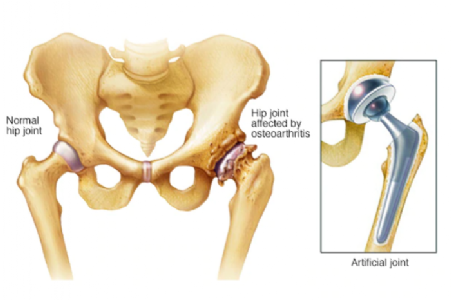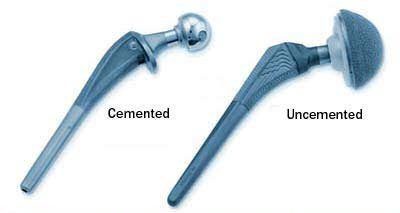Total Hip Joint Replacement
Total Hip Joint Replacement

Hip Replacement Overview
The hip joint is made up of a ball-and-socket. The socket is made of bone and cartilage, and the ball is the top of the thighbone, also known as the femoral head.
Hip replacement surgery is an operation used to replace the damaged ball-and-socket with new and durable artificial synthetic parts that mimic the ball-and-socket.
Sometimes, either the socket of the hip or the thighbone is injured or becomes diseased. This can result in pain, trouble with walking, or difficulty with everyday tasks. You may have already tried pain relief methods such as medications, physical therapy, supports, or braces. If the pain doesn’t subside, your doctor may recommend hip replacement surgery.
 WHO NEEDS A HIP REPLACEMENT?
WHO NEEDS A HIP REPLACEMENT?
Most people who have hip joint replacements are between ages 50 and 80. These surgeries are usually performed for arthritis of the hip. Arthritis is a disease that breaks down cartilage (the cushion between bones). Without cartilage, the bones rub against each other, which can cause severe pain.

Rheumatoid arthritis
An autoimmune disease that leads to joint inflammation

Traumatic arthritis
Damage to the joint caused by an injury

Osteoarthritis
A degenerative form of arthritis that’s most common in older adults.
 WHAT ARE THE DIFFERENT TYPES OF FRACTURE ?
WHAT ARE THE DIFFERENT TYPES OF FRACTURE ?
Fractures can be classified as closed or open, as well as incomplete or complete.
Doctors usually try to control arthritis discomfort with the use of walkers or canes, a low-impact exercise program, and nonsteroidal anti-inflammatory drugs (NSAIDs) such as ibuprofen. If these measures fail, a hip joint replacement is the best solution. You should consider a hip joint replacement if you can’t sleep or sit comfortably because of the pain, or if your arthritis limits your activities.
Hip replacements can also be used for other health conditions. For instance, they’re sometimes used if a tumor grows in the hip joint. Hip replacements may also be used in an emergency to fix a fracture in the hip joint or the thighbone. A condition called avascular necrosis of the hip often requires a total hip replacement.

 HOW IS THE NEW HIP CONSTRUCTED ?
HOW IS THE NEW HIP CONSTRUCTED ?

The replacement hip is made up of four components:
I. A metal socket
II. A liner to help the ball move easily within the socket
III. A metal or ceramic ball to replace the femoral head
IV. A metal rod used to stabilize the thigh bone to which the ball is attached
There are different options of joint prosthesis. Most surgeons use uncemented joint prosthesis, which allows bone to grow into the prosthesis over time.

A cemented prosthesis, on the other hand, is attached to the hip with bone cement for quicker adhesion. While both options have similar success rates, they have differences in terms of recovery.
Uncemented joints take longer to attach to the bone, so the recovery time is longer. Cemented versions, while quicker, are best used for older adults or for people who are not as active.
Another option to consider is a muscle sparing hip replacement. Unlike traditional hip surgery, this procedure spares cuts through the muscles, which reduces pain and recovery time.
Muscle sparing procedures are commonly performed through anterior or posterior. The main difference between anterior and posterior is the location of the incision. Anterior incisions are made in the front by the upper thigh, while posterior incisions are made in the back of the hip.

 HOW IS HIP REPLACEMENT SURGERY PERFORMED ?
HOW IS HIP REPLACEMENT SURGERY PERFORMED ?

Unless you are having emergency hip replacement due to an accident, your surgery will likely be scheduled several weeks in advance. Your doctor will urge you to use the time to get into the best physical condition possible.
They may suggest that you lose some weight. You will also need to stop taking any medications, including blood thinners. During this time, you may also want to rearrange your living space to minimize having to walk long distances or up and down stairs. For example, you might consider:
Preparing Meals In Advance And Freezing Them
Placing Everyday Items Within Arm’s Reach To Avoid Overexertion
You will not be able to eat or drink anything after midnight on the day of the surgery. Hip surgery is done in a hospital operating room. After you check in at the surgery desk, a nurse will take you into a room to be prepared for surgery. You will take off your clothes and put on a hospital gown, and the nurse will start an IV in your hand, wrist, or arm. The IV allows you to receive fluids and medications during the surgery.
When it’s time for your operation to begin, you will be taken into the operating room. There, you may be given a general anesthetic or a medicine that makes you sleep through the surgery so you don’t feel pain.
If your surgeon believes that you have other health issues that might make general anesthesia difficult or risky (such as heart or lung conditions), they may recommend a localized or regional anesthetic. This is a small amount of medication injected into your spine that makes everything below your waist numb. Some people who receive a localized or regional anesthetic are also given sedatives to help them remain calm during the surgery.
The procedure takes anywhere from one to three hours.

 HOW IS THE NEW HIP CONSTRUCTED ?
HOW IS THE NEW HIP CONSTRUCTED ?
Hip replacements generally have high success rates. In fact, the AAOS has called the hip replacement “one of the most successful operations in all of medicine.” Most people who have the procedure report significantly less hip pain and a greater ability to perform daily activities.
The most common complication is dislocation of the new joint. This usually occurs in people who do not let themselves fully recover before resuming normal activities. It can also occur in people who do not follow instructions for caring for the hip after surgery. However, with newer prosthesis, hip dislocation is greatly reduced. Infections and blood clots are potential complications, but procedures can help prevent these from occurring.
Hip joints last many years, but high-impact activity or obesity may shorten their lifespan. Some people have to get a second hip replacement if the first one begins to deteriorate. With newer designs and materials, however, they may even last several decades.

